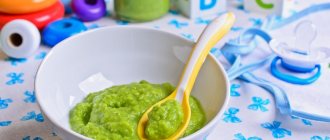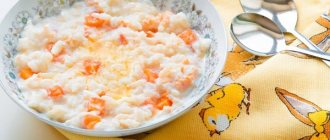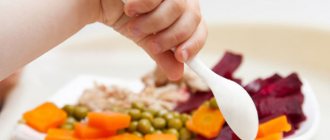Rules for creating a menu at 7 months
- At this age, the baby has most likely already tried vegetables, fruits, cereals and lean meats. Of course, the baby ate these foods in small quantities and got used to the new taste sensations. Now you can increase the portions of complementary foods. In total, the baby should receive 1000 ml or 1 liter of food. This is the same amount as he received at 6 months, but due to the fact that more solid food has been added to the diet, the caloric content of the diet is higher.
The menu of a 7-month-old breastfed child should not differ significantly from the menu of a bottle-fed child. After all, the adapted milk formula, as far as possible, repeats the composition of breast milk.
- At this age, you can give your toddler the first boiled egg yolk. Protein is given much later because it contains many allergens. Also, children should not be given raw yolk; it must be heat-treated, preferably boiled.
- Don't introduce several new products at once, do it one at a time. Otherwise, you need to stick to the diet with which you started complementary feeding and gradually increase the portions.
- At 7 months, a child should already have a clear diet. Pediatricians recommend feeding 5 times a day. Taking into account physiological needs, the number of feedings may differ slightly from the recommended one.
- Prepare your baby for an adult diet, that is, divide feedings into breakfast, lunch and dinner. And early in the morning and before bedtime, feed him breast milk or an adapted milk formula.
- You can add a little butter or vegetable oil to puree or porridge, but just a little, about 1 tsp.
- To cook meat properly, you need to know a few simple rules. Choose lean meat and boil it until done. Then puree it with a blender and add a little broth so that the puree is not too dry. At this age, it is important to thoroughly chop any food, especially meat.
- What kind of meat can you feed a 7 month old baby? Poultry and beef, but it is not recommended to give pork, it is too fatty, and moreover, it often contains many parasites.
- Dr. Komarovsky says that food prepared for a child should be lightly salted. Children's dishes should taste under-salted, but not completely bland.
- When preparing baby food, do not use any spices, especially spicy ones or those containing flavor enhancers.
- When creating a menu, the volume of fruit juice consumed is usually not taken into account.
How much should a baby eat
At 7 months, the baby should eat an amount of food per day that is 1/8 of his body weight, excluding juices, tea, compotes, and water. Drinks are not included in this figure. On average, this comes out to 1000-1200 grams of food. Divide this gram into 5 meals, it turns out that on average a baby should eat about 200 grams of food per 1 meal. This regimen will have a beneficial effect on the baby’s digestion, and he will not be bothered by a sore tummy.
It is important to feed the baby with breast milk (or formula) in the morning, a few hours later - a second meal, which already consists of complementary foods, then lunch, dinner, and before bedtime the baby can again be fed with formula or breast milk. The last meal before bed should be lighter than the previous ones so that the child's sleep is calm and comfortable.
For convenience, it is better to create a complementary feeding calendar.
Sample menu for 7 months. Dosages and volumes
| Feeding time | Dishes and volume |
| 6.00 | Breast milk or adapted formula (200 ml) |
| 10.00 | Porridge (150 g), boiled yolk (1/4 pcs.), supplementary feeding with formula or breast milk (50 ml) |
| 14.00 | Vegetable puree (170 g), meat puree (30 g), natural fruit juice (70 ml) |
| 18.00 | Fruit puree (70 g), baby cookies (1-2 pcs.), supplementary feeding with breast milk or adapted milk formula (130 ml) |
| 22.00 | Breast milk or adapted formula (200 ml) |
The table shows approximate nutrition for babies, which can be changed according to your needs. You can replace supplementary feeding with the mixture with something else, for example, high-quality cottage cheese, puree soup, etc.
Daily diet
It is very important to develop a child’s diet at 7 months so that the baby gets used to this routine and you do not have problems with it in the future. But if the baby refuses food, you should not force him to eat; it is better to feed him more nourishingly at the next meal. Make a weekly menu schedule for your baby, stick to it, and build an individual diet. If possible, you can consult your pediatrician. Make changes to the menu as necessary, replace some products with others if the baby refuses something.
Breastfed
The table shows the approximate daily diet of a breastfed baby by the hour.
| Feeding time | Menu | Serving Size |
| Meal 1: 6:00 | 1) breast milk; | 1) 200 ml; |
| Meal 2: 10:00 | 1) dairy-free or milk porridge; | 1) 150 gr. |
| 2) butter; | 2) ½ tsp. | |
| 3) egg yolk; | 3) ¼ tsp. | |
| 4) breast milk; | 4) 50 gr. | |
| Meal 3: 14:00 | 1) fruit puree: | 1) 170 gr. |
| 2) vegetable oil; | 2) 1 tsp. | |
| 3) meat puree; | 3) 30 gr. | |
| 4) fruit children's juice; | 4) 70 gr. | |
| Meal 4: 18:00 | 1) vegetable puree; | 1) 70 gr. |
| 2) children's cookies or crackers; | 2) 1-2 pcs. | |
| 3) breast milk; | 3) 130 gr. | |
| 5th meal: 22:00 | 1) breast milk; | 1) 200 gr. |
Artificially fed
The diet of a bottle-fed baby is not very different, but you can also look at it in detail in the table below.
| Feeding time | Menu | Serving Size |
| Meal 1: 6:00 | 1) infant formula; | 1) 200 ml; |
| Meal 2: 10:00 | 1) dairy-free or milk porridge; | 1) 150 gr. |
| 2) butter; | 2) ½ tsp. | |
| 3) egg yolk; | 3) ¼ tsp. | |
| 4) infant formula; | 4) 50 gr. | |
| Meal 3: 14:00 | 1) vegetable puree: | 1) 170 gr. |
| 2) vegetable oil; | 2) 1 tsp. | |
| 3) meat puree; | 3) 30 gr. | |
| 4) fruit juice; | 4) 70 gr. | |
| Meal 4: 18:00 | 1) fruit puree; | 1) 70 gr. |
| 2) children's cookies or crackers; | 2) 1-2 pcs. | |
| 3) infant formula; | 3) 130 gr. | |
| 5th meal: 22:00 | 1) infant formula; | 1) 200 gr. |
Prepared meals or home-cooked meals
All parents want to give their child the best, and this also applies to natural nutrition. Moms are faced with the pressing question of what to do: cook at home or buy ready-made food in the store? Dr. Komarovsky believes that not only proper nutrition of the baby is important, but also the microclimate in the family.
If an already busy mother stands at the stove all day long preparing purees and so on, then she will have little time left for the child, for dad, and especially for herself. This is detrimental to the relationship between husband and wife. Therefore, the pediatrician advises alternating preparing homemade food with buying high-quality and proven products for children in the store.
Kitchen helpers for healthy eating
It is worth remembering that food for children should be boiled or steamed, but under no circumstances fried. To make cooking easier, use modern kitchen gadgets.
- For heat treatment of food, you can use not only a saucepan. The multicooker also works great for cooking. It has a huge number of modes for various dishes. For children's kitchens, you can use the steaming and boiling mode. The advantage of a multicooker is that food almost never burns in it. In addition, you can set the required time period for preparing certain dishes. At the end of cooking, the multicooker turns off and keeps the dish hot for some time. Also, milk does not escape from the multicooker, because the lid closes tightly and, unlike a double boiler, it can be opened during the cooking process to check how the cooking is progressing.
- to make juices . Previously, when mothers had to grate fruits and squeeze the juice through cheesecloth, this took a lot of time. Now natural juice can be prepared much faster.
- To prepare the puree, you can use a blender or food processor. You can also make puree from boiled vegetables or fresh fruits.
Delicious and healthy recipes for 7 months
Meat puree
To prepare it, you need to take poultry or beef; you can also use offal, such as liver or beef tongue. Select 50 g of meat, rinse it and clean it of veins and various films and membranes. Boil over very low heat for 2 hours. An hour before it’s ready, you can throw a piece of onion and carrot into the broth. Grind the finished meat in a blender and add a little broth for tenderness.
Vegetable puree
It can be prepared only from vegetables, or it can be prepared with the addition of meat puree. Wash and peel 100-150 g of vegetables. Then boil them in a saucepan or steamer in a slow cooker. Grind with a powerful blender and add one of the suggested ingredients. For example, meat broth, a little meat puree or a teaspoon of butter or vegetable oil.
Cottage cheese with apple
To prepare cottage cheese, take special children's kefir. Pour it into a saucepan and heat over low heat. Kefir should be heated carefully until warm and under no circumstances should it boil. During heating, make sure that the kefir curdles, but does not become too hard. When you see that the mass has become like cottage cheese, place it in a sieve or colander. Add applesauce to the finished cottage cheese.
Menu for a 7 month old baby: creating a healthy diet
The baby is 7 months old, he is already sitting and leads a fairly active lifestyle . What should be the menu for a 7 month old baby ? We will tell you in our article what a baby needs at this age and what dishes can diversify his diet so that the baby’s body receives healthy vitamins and microelements.
new products into the menu of a 7-month-old baby , especially if the process of complementary feeding has begun and vegetables , fruits and cereals . What new flavors can you offer your baby?
Meat
7 months meat into the child’s diet ; it contains a lot of essential protein, which will serve as a building material for a growing body, vitamins A, B, B12 and easily digestible iron. You can offer your baby lean beef, veal, rabbit, turkey or chicken.
The meat must be boiled, ground in a blender, and adding a little broth so that it is not dry, and serve to the baby separately or, for example, mix with vegetable puree, add to soup or cook it in meat broth.
If meat from special canned food for children is introduced into a child’s diet, then it is better to start with homogenized options containing only meat , and one type, without additional components.
In children prone to food allergies, meat selection is carried out taking into account individual tolerance . When purchasing, be sure to pay attention to the composition of the canned food and the age at which this product can be used. Usually all the necessary data is indicated on the packaging.
Remember to follow the rules for introducing a new product to your child’s menu: first, let the baby try just a little bit of meat and look at his body’s reaction; if everything is fine during the day, the next day you can give the baby a little more, and gradually, day after day , bring the quantity of the new product to the required level.
Read also : Rules for healthy complementary feeding
Our forum member mother Elya says : “I give meat for lunch, and since my son doesn’t really like it separately, I mix it into soup or vegetable puree. I tried adding breast milk to the meat, but it didn’t want a little buckwheat porridge. But he eats it with vegetables, thanks for that too.”
Yolk
Another new product is the yolk , the most valuable part of a chicken egg. The yolk contains unsaturated fatty acids, fat-soluble vitamins A, E and D and carotene, as well as phosphorus and iron.
Parents should take into account that we are talking specifically about the yolk , and not about the whole egg, since the white is a fairly allergenic product. However, when giving your baby a yolk, you also need to make sure that the baby does not have any negative reactions to it. Like any new product on a child’s menu, pediatricians recommend introducing the yolk carefully, without mixing it with other new products. There is an opinion that quail eggs are an excellent solution for children with allergies, but allergies can also occur to the protein of quail eggs.
The opinion of Dr. E.O. Komarovsky on this matter is as follows : “There is no fundamental difference between a chicken egg and a quail egg. Whatever bird eggs you choose, they should be given to the child in a heat-treated state. Giving your child raw eggs is fundamentally wrong. Because absolutely all birds can be carriers of such a dangerous disease as salmonellosis. Sometimes, when a child loves eggs very much, it is difficult for parents to give him half a chicken egg, but a quail egg is just right.”
When creating a menu for a 7-month-old baby, it is worth distributing dishes in such a way that the second feeding acts as breakfast, and the meal around 14.00 is lunch. Parents should gradually form in their child the traditional adult division of food during the day for breakfast, lunch, afternoon snack and dinner. After all, soon the number of meals the baby will have will be reduced, but the healthy habit of eating porridge for breakfast, soup for lunch, and cottage cheese for an afternoon snack will remain, and this dietary regimen will seriously make life easier for parents.
However, if a child eats vegetable puree better in the morning or evening, and likes porridge during the day, there is nothing wrong with that, feel free to be guided by his preferences and tastes.
What, when and why
At the age of 7 months, the child eats five meals a day , the interval between meals is 4-4.5 hours. The first and last feeding is either breastfeeding or, if the baby is bottle-fed, an adapted formula.
Our mother, a member of the House forum, says : “Our menu is as follows: 7-00 breast, 10-00 porridge (any), 13-00 meat puree with vegetables (2-3 times a week, half a yolk), 16-00 cottage cheese, fruit puree, breasts at 19-00, breasts at night at 21-30. And he wakes up every 2 hours all night to eat. We rarely drink juices and then they are heavily diluted with water, sometimes I give a compote of dried fruits, and most often - plain drinking water.”
If we take into account that vegetable purees, juices, cereals, meat, yolk and dairy products have already been introduced into the baby’s complementary feeding, then the approximate menu for a 7-month-old baby may look like this :
After waking up - breast milk or an adapted formula
Breakfast – around 10.00
- porridge with milk or dairy-free - 150 g;
- fruit puree - 70 g.
Lunch - around 14.00
- vegetable puree or vegetable soup with meat - about 180 g;
- you can add 1 teaspoon of vegetable oil to puree or soup;
- 1/2 grated yolk;
- juice or fruit puree - 30 ml.
Afternoon snack - around 18.00
- porridge with milk or dairy-free - 50 g;
- cottage cheese - 30 g.
- juice or fruit puree - 30 ml.
- cookies - 1-2 pcs. (optional)
Dinner - breast milk or adapted formula
If your baby doesn’t eat well or doesn’t get enough of the foods offered, offer him breast or formula after each meal .
If both meat and yolk are introduced into the baby’s menu, then first it is advisable to separate the new foods into meals, and give, for example, the yolk for breakfast or an afternoon snack, and meat for lunch.
What if he doesn’t want to?
We are sure that parents should not be nervous if the child flatly refuses to try one of the dishes we offer - all children are individual , each has their own taste and different rates of introducing new dishes.
Our forum member mother Vikusia says : “Lina wanted to try her first complementary foods at 10 months. Before that, it was only breasts, and everything that I offered her from cereals, purees and soups ended up on the floor or on the feeding table. At first I was nervous, and my grandmothers insisted, how could it be that the baby doesn’t get anything from mother’s milk, she doesn’t have enough, she’ll get rickets, we need to feed her “like a human.” But when we weighed ourselves at the pediatrician’s appointment at 6, 7, 8 months, and the little one was gaining 800 g per month on my milk alone, the doctor said there was nothing to worry about. If he wants to, he will start eating something new; no one before school had ever eaten only breast milk. Relax, mommy. And I relaxed, which is what I wish for everyone. Listen to your child - this, of course, is difficult to admit, but he really knows better.”
No aspect of raising a child causes as much controversy and worry as nutrition. Of course, adults wish only the best for the baby, but remember that the main assistant in creating the right menu is your baby.
After all, sometimes refusing such important products in your opinion and prepared with love is justified, for example, the baby’s body still does not have enough necessary enzymes to digest them, and force-feeding the baby may subsequently become a reason for a visit to a nutritionist or endocrinologist.
Listen to your baby and everything will be just fine!
Read also : Where to start complementary feeding in the summer
Drinks at 7 months
What can you feed a baby at seven months?
- The main and healthiest drink for both children and adults is water. When purchasing drinking water, inspect the packaging; it should state that the water is intended specifically for small children. It should be non-carbonated, odorless and sediment-free. Only after one year can babies drink mineral table water, but also without gas.
- It is not advisable to give children regular black or green tea, and teas with flavors or additives such as exotic fruits are strictly prohibited. There are special instant teas for infants ; they are made from medicinal herbs and are very healthy. Of course, it is worth taking into account the individual characteristics of the body and allergic reactions to herbs. When choosing tea, look at the packaging at what age it can be consumed.
- As for compote, it is advisable to prepare it from dried fruits without adding sugar. But you can use fresh fruits or berries to prepare it, again, taking into account possible allergies.
- Juices for infants should be introduced into the diet gradually , starting, literally, with a few drops. If you do not see a negative reaction, then you can increase the volume to a teaspoon and then a tablespoon. The best option is apple juice; it practically does not cause allergies and is very useful for children. If you have already checked the baby’s reaction and are completely confident in apple juice, then you can introduce the next fruit into the diet. Do not rush to try exotic foods, especially citrus juices, they often cause allergies. If you want to buy juice in a store, choose products specifically for infants. Regular juices are made with a lot of coloring and sugar. Such a product will definitely harm the child’s health. It is also worth remembering that beet juice is quite aggressive, so it should be used with caution. And freshly squeezed carrot juice can cause allergies.
It is strictly forbidden for infants to be given adult drinks such as soda, energy drinks, hot chocolate, coffee and juices that are not intended for children.
- It is not advisable for infants under one year of age to consume cow's milk in its pure form. Even for porridges, it is best to use milk mixtures. If you want to introduce dairy products into your toddler's diet, let it be kefir, cottage cheese or children's yogurt without dyes. Be sure to choose only high-quality dairy products made specifically for babies.
Feeding regimen for a 7-month-old child with allergies
If a child has a food allergy, the allergen product must be removed from his diet. It’s good if a reaction occurs to fruits or certain vegetables - everything is simple, but often you have to deal with an allergy to cow protein. This allergy makes significant adjustments to the baby’s diet. With her, the feeding scheme for a 7-month-old baby looks like this.
6 a.m
During the first feeding, the baby should be fed breast milk, a fermented milk product from the children's kitchen, a formula based on protein hydrolyzate or soy. Serving size – 180-220 ml.
10 a.m
Children without allergies receive milk porridge for second breakfast, and those with allergies receive dairy-free porridge with a small addition of breast milk or a product that usually replaces it. The serving size is 170 grams, there is no point in giving up butter and fruit puree.
2 p.m.
The third feeding menu, recommended for children at this age, does not involve the use of dairy products, and therefore the feeding scheme for a 7-month-old child with an allergy to milk protein does not change here. Vegetables with vegetable oil, meat and fruits, excluding allergens - everything is standard.
6 p.m.
Evening milk feeding for allergy sufferers is replaced with fully grown-up food: 170 grams of porridge with vegetables and vegetable oil, 20-30 grams of meat puree and 30 grams of fruit puree as dessert.
Interesting topics about nutrition
- Read how to do the first complementary feeding while breastfeeding.
- Learn more about complementary feeding by month while breastfeeding.
- Do you know what diet to follow while breastfeeding?
- We will also tell you - is it possible to eat seeds while breastfeeding?
Girls, please answer a few questions in your comments. Tell us how your little one eats at 7 months? What drinks does your baby prefer? Also tell us how you are doing with night feeding and how many times a day does your baby eat?
Features of complementary feeding for a seven-month-old baby
The main feature of complementary feeding for a 7-month-old baby who is breastfed or bottle-fed is the inclusion of meat products in the baby’s menu. The body is saturated with the necessary amount of protein, and the development of anemia is prevented.
Breastfed
Complementary feeding at 7 months during breastfeeding is an independent nutrition, replacing one, then several feedings with milk or formula. If the baby is fed with mother's milk, after each complementary feeding the baby is put to the breast, ensuring longer maintenance of lactation.
On artificial
Complementary feeding for a 7-month-old bottle-fed baby is mashed products containing one ingredient of soft consistency. Safe and healthy options would be mono-component puree, factory-produced porridge, home-cooked dishes: ground rice, fruit and vegetable purees. The baby's body also needs animal proteins. The menu should be supplemented with meat puree (rabbit, turkey, chicken, veal).










